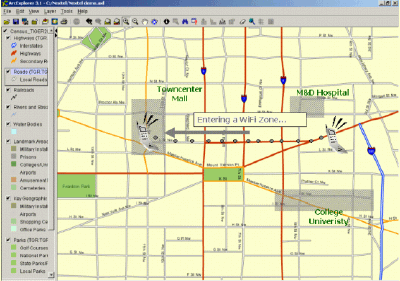Over the last several years, WiFi networks have been cropping up everywhere. Corporate campuses, college campuses, shopping malls, train stations, airports, museums, hospitals, manufacturing plants, warehouses, and even Starbucks coffee shops have all installed WiFi networks on their premises. The trend suggests the world is becoming more unwired, hungrier for wireless broadband access, and that computing is becoming more miniaturized and pervasive.It also suggests that perhaps many are tired of waiting for 3G wireless data services and that WiFi may potentially threaten 3G plans and rollouts unless wireless carriers can find a way to offer an overlay of both technologies to device-toting users.
A New, Useful LBS Application: Cellular-to-WiFi Service Hand-off
There are two obvious problems with marrying conventional cellular
networks to WiFi networks. First, not all mobile devices support
both cellular bearers (GSM, CDMA, iDEN, etc.) and IEEE 802.11b, though
I'm sure most handset manufacturers have plans to solve this over time,
as some already have.Second, and perhaps more important and critical,
cellular-to-WiFi service hand-off has not been solved. When a user
on a cellular network enters into a WiFi coverage area, there is no mechanism
in place to hand off the call from the cellular network to the WiFi network.
Can location be used to unravel the problem? Can location capabilities
in cellular networks be used as a mechanism to manage WiFi service hand-off?
The answers to these questions can be found through geography and by thinking
geographically.
WiFi networks are typically confined to small geographic areas like
a campus, and these areas, or footprints, can be mapped and represented
by GIS databases as geographic zone features similar to a demographic area,
postcode, ZIP Code, or other semantically defined geographic zone.
Conventional cellular networks that already support location capabilities
through A-GPS, TDOA, etc.are capable of tracking device locations.
Combine this cellular location capability with a WiFi coverage zone map,
and you now have the ability to intelligently trigger a cellular-to-WiFi
services hand-off based on location when a user enters into a WiFi zone
(Figure 1).

Figure 1.GIS Representation of a Cellular-to-WiFi Services Hand-off
Based on Location
This hand-off trigger is based on the same premise of location-based
presence for the purposes of zone-based alerting in cellular networks,
but the zone happens to be a WiFi area in this case. Cellular-to-WiFi
hand-off is a location-based application in itself, and it directly benefits
wireless carriers that build out WiFi hot spots (e.g., T-Mobile USA).
However, you need not stop there. There are more possibilities for
WiFi in location-based services.
Dig Deeper Into WiFi: Micro-LBS Is in There, Too
In addition to the cellular-to-WiFi hand-off issue, seamless outdoor/indoor
positioning and ubiquitous location are two other challenges facing the
LBS industry. For example, A-GPS positioning methods work well in
urban outdoor environments, but they are quirky, unreliable, and their
accuracy degrades when the device is indoors and has limited line-of-sight
to satellites. In response to this problem, some vendors have invested
in research and development to address location-enabled WiFi networks for
indoor positioning (see www.ekahau.com).
These vendors have successfully built software-only, server-centric solutions
capable of positioning WiFi-enabled devices to one meter or less in indoor
and outdoor environments or wherever there is adequate WiFi coverage.
While these WiFi solutions' technical details are intriguing and are based
on geographic information system (GIS) data modeling of signal strengths,
I will focus on the more broad implications of the technology and how it
may solve the problem of ubiquitous location between the cellular and WiFi
worlds, and also how the technology could potentially introduce a new breed
of "microgeography" LBS applications.
Imagine the proverbial mass-market oriented LBS transaction scenario, where a mobile user is trying to find an ATM nearby. The user would likely invoke a location-based concierge application whereby the cellular network would determine his/her location and he/she would subsequently receive details about the point-of-interest destination within a given proximity. The details of the returned information might include directions to the site and other relevant information. Upon receiving the information, the user decides to travel to the destination, which for the purposes of this example is within a shopping mall. The ATM is inside the mall, which is quite large. In a cellular-to-WiFi handoff-enabled world, the user would receive additional directions once inside the mall based on WiFi location capabilities and would quickly find the ATM. This is an exhausted service example that in the real world has little value to the average user, but it is used here to explain the basic idea behind the technology.
There is also potential for stand-alone WiFi microlocation-based applications
independent of cellular networks. Location-enabled WiFi networks
covering corporate campuses, college campuses, shopping malls, train stations,
airports, museums, hospitals, manufacturing plants, and warehouses provide
micro-GIS application possibilities for business, education, retail, transportation,
health care, and the supply chain management industries, respectively.
These industries have demand for these types of location technologies and
spatial solutions. For example, hospitals are looking for ways to
track doctors, patients, and medical resources.Shipping companies
are looking for ways to track packages and supply chains within their warehouses.
Manufacturing plants are interested in monitoring and tracking assembly
lines and production flows.Students are interested in campus-based
friend finder applications. The list goes on and on, and the imagination
can run wild with possibilities.
Conclusion: The Symbiotic Power of Location
Location in cellular networks can be used to solve WiFi hand-off challenges.
Location can be used in WiFi networks to introduce a whole new set of micro-GIS
location-based applications.Finally, location itself creates a symbiotic
relationship between both networks, bringing them together to create location
ubiquity.The industry colloquialism "power of location," and ESRI's own
saying, "geography creates communities," both hold true in this case.
Geography is truly a wonderful thing!
Reprinted with Permission.Copyright 2003 ESRI.All rights reserved.